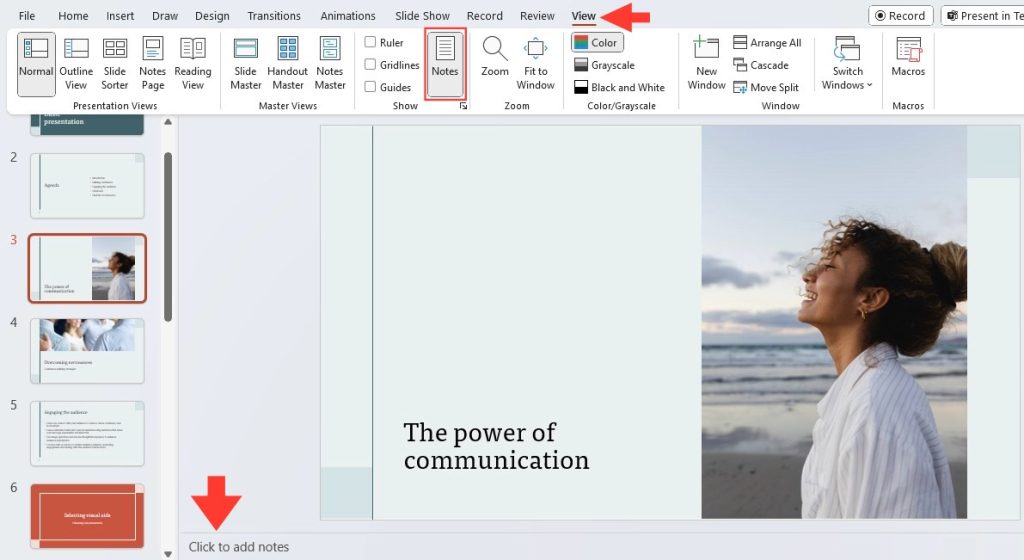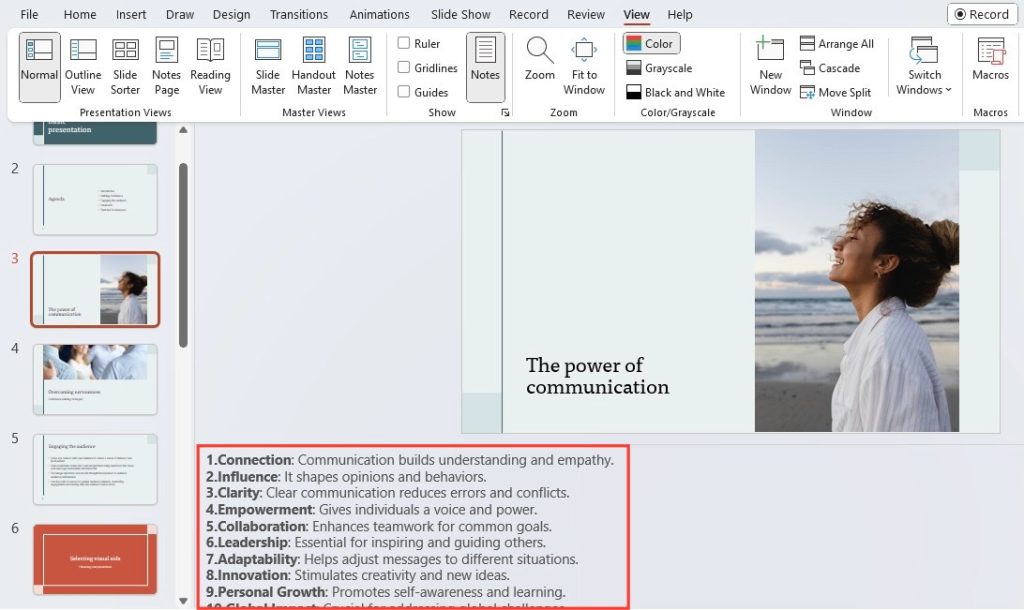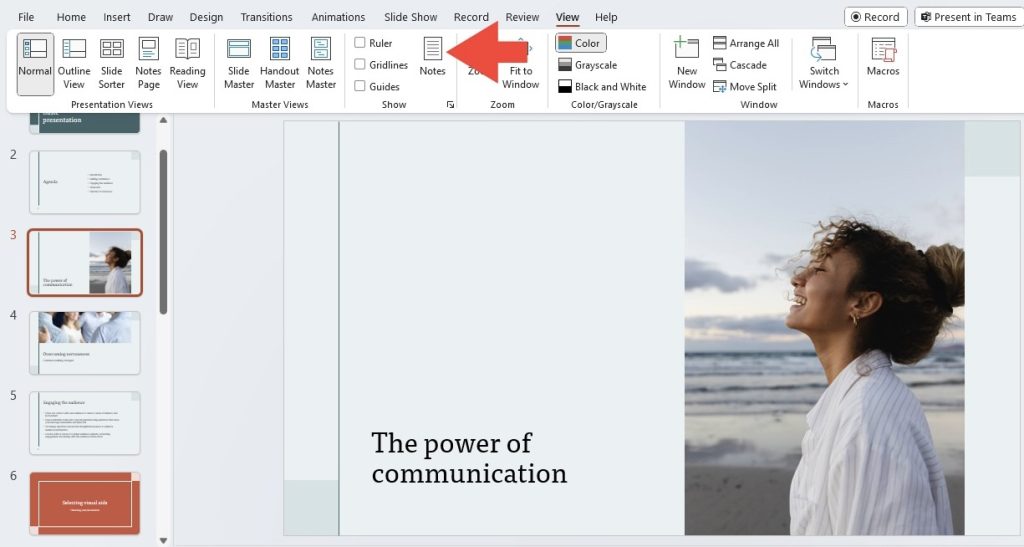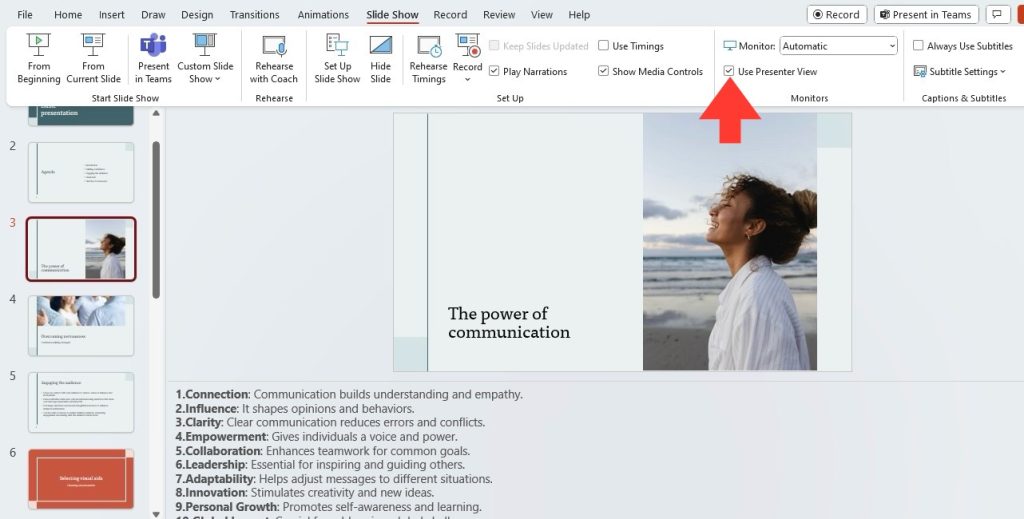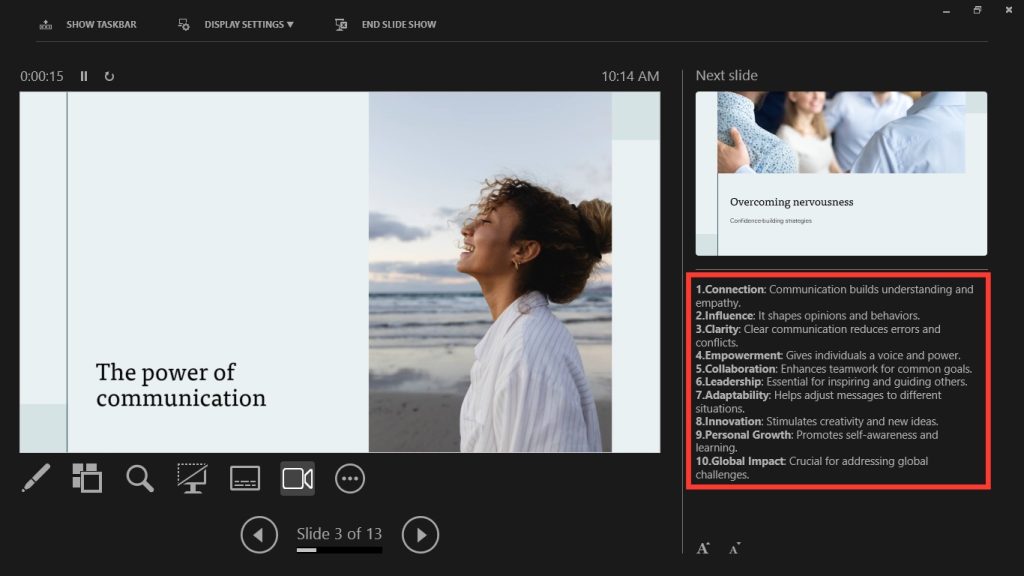Speaker notes in PowerPoint are the unsung heroes that carry you confidently through your presentation. Imagine them as your prompter, cueing you with all the vital information you need to mention without cluttering your slides. This tool ensures you touch on all necessary points while maintaining a strong connection with your audience. When effectively used, notes can dramatically refine your messaging and help you deliver a talk that’s both polished and engaging.
Download our 141 Free Excel Templates and Spreadsheets!
Key Takeaways
- To add speaker notes in PowerPoint, select the slide you want to annotate, then click on the notes pane below the slide. If the notes pane isn’t visible, click on “View” and select “Notes” or drag the divider bar upward on a Mac to display the notes section.
- You can type or paste your desired content directly into the notes pane where it prompts “Click to add notes.” This helps to ensure you remember all key points and important information during your presentation.
- Remember to save your presentation after adding your speaker notes to each slide to keep your speech guidance integrated with the slideshow, enabling a smoother delivery when presenting.
The Underrated Tool for a Memorable Talk
Often overlooked, speaker notes are the stealthy companion that makes all the difference in a presentation. While your slides are the visual attraction, notes are the storyboard behind your story—keeping your narrative tight, your jokes timely, and your facts at the ready. When you reduce your reliance on overt prompts or excessive glances at your slides, you come across as more natural and approachable. Embrace the underrated power of speaker notes, and witness how they transform your next talk into an experience that resonates and sticks with your audience long after you’ve concluded.
Table of Contents
Step-by-Step Guide to Adding Speaker Notes
Single Slide Wizardry: Adding Notes with Precision
Adding notes to your PowerPoint slides is a breeze with the right approach. Start by selecting the slide to which you wish to add notes. Just beneath your slide, you’ll find the “Notes” pane waiting for your insights. There’s no need to crowd your slide with text when you can discreetly type all you need to remember here. Whether it’s a single keyword to jog your memory or detailed bullet points for elaboration, your notes stay invisibly attached to each slide, enhancing the precision of your delivery. Here’s how to do it:
STEP 1: Open your PowerPoint presentation.
STEP 2: Go to the “View” tab in the PowerPoint ribbon.
STEP 3: Click on “Notes Page” in the Presentation Views group. This will display your current slide with a space below it for adding notes.
STEP 4: Click in the area below the slide to add your speaker notes. Type your speaker notes directly into the text box.
STEP 5: Repeat this process for each slide in your presentation, adding speaker notes as needed.
STEP 6: To return to the normal slide view, click on “Notes” again in the Presentation Views group on the “Show” tab.
Remember, it’s all about staying organized and succinct. Add just enough detail to guide you, but keep it concise enough to prevent overwhelming yourself. This nifty feature keeps your presentation smooth and makes sure you don’t skip a beat.
Mastering the Art of Bulk Notes: Enhance Multiple Slides Simultaneously
Conquering the art of bulk note enhancement allows you to efficiently handle larger presentations. If you need to add the same context or reference to multiple slides, start by selecting the slides you want to edit by using “Shift” to highlight them all in one go. Then, head over to the “Notes” pane and let your thoughts flow uniformly across these slides. This harmonizing method saves you time and ensures consistency throughout your presentation.
For a more comprehensive view, switch to the “Notes Page” under the “View” tab. Here, you can scroll through each slide and edit the notes in a document-style format. This split-screen approach lets you oversee both your slide and notes in one glance, making bulk modifications a walk in the park.
Whether you’re providing a uniform disclaimer, repeating a mantra, or setting a thematic note, mastering this technique will make sure your presentation is coherent and every slide is prepared to make the impact you desire.
Crafting Perfect Speaker Notes
What to Include in Your Notes for Maximum Impact
To ensure your speaker notes pack a powerful punch, focus on including cues that will aid your narrative and keep you on track. Consider incorporating brief reminders of stories or anecdotes you plan to tell, key statistics you want to emphasize, and transitional phrases that will help you shift smoothly from one idea to the next. Also, jot down any technical terms or definitions that you want to explain to avoid getting stuck mid-presentation.
Bullet points work excellently to list down these essential elements. Additionally, think about inserting questions that you anticipate from your audience or that you will ask them. This prepares you for interactive segments and keeps the engagement flowing. These strategic inclusions make your notes a robust framework supporting the entire weight of your compelling presentation.
Key Considerations and Common Mistakes to Avoid
Crafting perfect speaker notes is a delicate balance – less is often more. When penning notes, keep them succinct; the goal is to glance, not read verbatim. The key considerations include brevity, clarity, and relevance. Prioritize the key concepts, phrases, and data that anchor your narrative, ensuring that nothing critical is left unspoken.
Beware of these common pitfalls:
- Data Overwhelm: Your notes should be pointers, not a manuscript. The more text you see, the more likely you’ll be swamped with unnecessary data. Aim for brevity.
- Overlooking Format: Embrace structure via bullet points and bold text for key points. Familiar formats save you thinking time and highlight your presentation’s crucial components.
- Bypassing a Review: Always revisit your notes for coherence and relevance. Spending considerable time creating your presentation can desensitize you to errors. Review them after a break to ensure they are error-free and effective.
Utilizing Speaker Notes During Presentations
The art of Reading Speaker Notes Discretely While Presenting
Mastering the art of discretely consulting your speaker notes can make the difference between a good presentation and a great one. It’s all about the subtlety of your glances – quick, brief looks that don’t interrupt the flow of your delivery. Position your notes, whether on cue cards or a screen, where a swift, downward eye movement enables you to peek without significant head movement. Timing is also key; synchronize your looks with natural pauses or while the audience is reflecting on a slide image.
Practice makes perfect, so rehearse with your notes to get the hang of this discreet dance of eyes. The audience will appreciate your seemingly effortless command of the subject, and you’ll enjoy the safety net your invisible guide provides.
Switching Seamlessly Between Off-Screen Notes and Direct Engagement
Effortlessly moving between your notes and engaging directly with your audience is a skill that elevates your presentation from informative to captivating. To achieve this, familiarize yourself deeply with the content of your notes. This familiarity allows you to reference them quickly, without lingering, and return your gaze to the audience to maintain connection and immediacy.
Try to align the moments you consult your notes with transitions between slides or while the audience’s attention is on a visual element. This way, you maintain the ebb and flow of the presentation. Regular practice in simulating the presentation environment will help you internalize the rhythm of when to switch your focus, making these transitions appear smooth and maintaining the spellbinding engagement with your audience.
Advanced PowerPoint Note Handling
Hiding Your Notes from the Audience View
When you’re ready to showcase your presentation, you’ll want to make sure your carefully crafted notes are for your eyes only. To keep them hidden, PowerPoint offers a slick solution: the Presenter View. Enable this feature by ticking the “Use Presenter View” box in the “Slide Show” tab before you start your presentation. Use the shortcut Alt+F5 to go in to Presenter View. And the Esc button on your keyboard to exit the Presenter View.
In Presenter View, you can see your notes on your own screen, while the audience only sees the slides. It’s akin to having a secret teleprompter that guides you without exposing your behind-the-scenes preparation.
Be sure to test this feature before going live to ensure compatibility with your setup. By doing so, you’ll present with confidence, knowing your insider cues remain invisible.
FAQs: Mastering Speaker Notes in PowerPoint
How Can I Access Speaker Notes During a Live Presentation?
During a live presentation, you can access your speaker notes by using PowerPoint’s Presenter View. This feature displays your current slide, the next slide, and your notes on your screen, while the audience only sees the current slide. Simply connect your computer to the projector or second screen, and PowerPoint typically offers the option to switch to Presenter View automatically. Remember to familiarize yourself with this function beforehand to ensure a smooth experience.
What’s the Best Practice for Writing Speaker Notes in PowerPoint?
The best practice for writing speaker notes in PowerPoint is to keep them concise and easy to skim. Use bullet points to break up information, and highlight or bold key terms to draw your eye during the presentation. Notes should serve as cues or prompts, not a script to read from, allowing you to speak naturally and engage with your audience. Also, rehearse with your notes to ensure a smooth delivery.
Is It Possible to Print Only Speaker Notes Without Slides?
Yes, it is entirely possible to print only speaker notes without including slide thumbnails in PowerPoint. After clicking on ‘File’ and navigating to ‘Print’, choose ‘Notes Pages’ under the ‘Settings’ section. Then, you just need to delete the slide thumbnails from each ‘Notes Page. Once done, your speaker notes are ready to be printed, offering you a clean, slide-free document to review.
Can Speaker Notes Be Used Effectively for Web-Based PowerPoint Presentations?
Absolutely! Speaker notes are just as effective for web-based PowerPoint presentations as they are for in-person ones. When presenting online, ensure you have dual monitors setup – one for the presentation as the audience sees it, and the other with Presenter View for your notes. Alternatively, if you’re limited to a single screen, you can split your display or use a tablet or smartphone as a secondary screen for your notes. Maintaining eye contact with the camera while glancing at your notes promotes a more natural delivery, even virtually.
John Michaloudis is a former accountant and finance analyst at General Electric, a Microsoft MVP since 2020, an Amazon #1 bestselling author of 4 Microsoft Excel books and teacher of Microsoft Excel & Office over at his flagship MyExcelOnline Academy Online Course.

